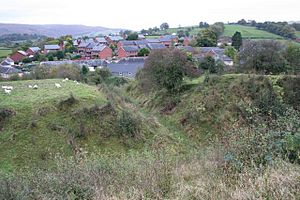Builth Castle facts for kids
Builth Castle (Welsh: Castell Llanfair-ym-Muallt) was a strong castle built by King Edward I. It stood near Builth Wells in Powys, Wales. Once, it was a grand stone castle. But over many years, its stones were taken away. Now, only the big mound, ditches, and earth walls are left.
Contents
History of Builth Castle
Builth Castle was built in 1277. It was the first castle King Edward I started in Wales. The spot chosen already had an older motte-and-bailey castle. This old castle had a large mound (motte) and two courtyards (baileys).
Building the Castle
The older castle had been fought over many times. Llywelyn ap Gruffudd had largely destroyed it in 1260. It's not clear how much was left when Edward I began his stone castle. Building started in May 1277. It continued until August 1282.
The castle was left unfinished because of money problems. King Edward I also changed his plans. He wanted to focus on invading Gwynedd instead. The total cost of the castle was about £1,666. This was not a huge amount. It was cheaper because the earthworks were already there.
Important Events and Owners
In 1294, the castle was attacked during a revolt led by Madog ap Llywelyn. On February 7, 1301, King Edward I gave Builth Castle to his son, Edward.
Later, a powerful lord named Roger Mortimer looked after the castle for King Edward II. When Edward II became king, he gave the castle to his wife, Queen Isabella. Isabella then rented the castle back to Roger Mortimer.
Changes in Power
Roger Mortimer became very powerful. He and Queen Isabella worked together to take power from King Edward II. Later, in 1330, King Edward III (Edward II's son) grew up. He arranged for Mortimer to be captured. Mortimer was then punished for treason.
King Edward III took Mortimer's property. Builth Castle was given to Alice de Lacy and her husband, Eubulus le Strange. They were rewarded for helping the King. After they passed away, the castle went back to the King.
The Black Prince and Later Years
King Edward III then gave Builth Castle to his son, the Black Prince. The Black Prince rented it back to the Mortimer family. But he kept the right to put soldiers there during wars.
The castle was attacked again in the early 1400s. This was during the revolt led by Owain Glyndŵr. The soldiers defending the castle were led by Sir John Oldcastle. The castle was repaired in 1409.
End of the Castle
The rental agreement ended during the War of the Roses. This was a big fight for the English crown. Later, in 1493, Builth Castle became part of a special area called a Marcher Lordship. It was given to Prince Arthur, the son of King Henry VII.
However, Prince Arthur died young in 1502. During the time of his brother, King Henry VIII, the castle burned down. Over the years, local people took stones from the ruins. They used the stones to build their own homes.
What Remains Today
Today, all the stone parts of Builth Castle are gone. Only the impressive mound, ditches, and earth walls remain. It is hard to imagine the grand stone castle that once stood there. But these earthworks still show how big and important it was.


